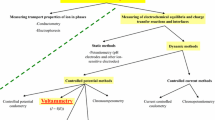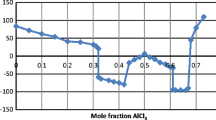Abstract
Equations are given for describing the differential temperature curves of phase transformation (fusion and solidification) and allotropic transformations, as well as of dismutation reactions proceeding without any change in weight. It is shown how the obtained relationships are modified according to whether the reaction proceeds with or without weight change. Finally, the properties of the derivative d/dt gDT are established theoretically that can be used to advantage in the investigation of heterogeneous kinetics on the basis of DTA curves.
Résumé
Dans cette seconde partie, en désignant parθ la vitesse de chauffe supposée constante etα(t) un paramètre dépendant du tempst, caractérisant le degré d'évolution de la transformation considérée, on établit les équations des courbes de température différentielleΔT== f [θ, α(t)] dans le cas des transformations de phase (fusion, solidification) des transformations allotropiques et dans le cas des réactions de dismutation sans variation de masse. On montre également comment les relations obtenues sont modifiées lorsque l'on considère les réactions avec ou sans variation de masse, inverses de celles déjà étudiées. Enfin, on établit théoriquement les propriétés de la dérivée d/dt ΔT, propriétés dont une est mise à profit dans certaines études de cinétique hétérogène faites à partir des courbes d'analyse thermique différentielle.
Zusammenfassung
Die Gleichung der differentialthermoanalytischen KurveΔT == f[θ, α(t)] für den Fall von Phasenumwandlungen (Schmelzen, Erstarren), von allotropen Umsetzungen und von ohne Gewichtsänderung verlaufenden Umwandlungsreaktionen wurden theoretisch abgeleitet, wobeiθ die konstante Aufheizungsgeschwindigkeit,α(t) ein zeitabhängiger, den Verlaufsgrad der Reaktion kennzeichnender Parameter ist. Es wurde gezeigt, wie sich die erhaltenen Beziehungen ändern, wenn die Reaktionen mit oder ohne Gewichtsänderung in entgegengesetzter Richtung verlaufen. Gewisse Eigenschaften der Derivierten d/dtΔT wurden theoretisch untersucht. Eine von ihnen läßt sich bei der Untersuchung der Kinetik von heterogenen Reaktionen durch die Differentialthermoanalyse verwenden.
Резюме
В данной части II для слу чая превращений, заключающихся в изме нении фазы (плавление, затве рдевание) аллотропно м изменении и дисмутадии без изме нения массы, введено теорет ическое уравнение из менения температурыΔT=f[θ,α(t)], гдеθ является постоянно й скоростью нагрева,α(t) — параметр, зависящий от времени, описывающ ий развитие превращени я в течение экспериме нта. Показано как можно из менить эти соотношения в слу чае реакций обратных тем, которые были изучены без изме нения массы. Установлены те оретически некоторы е особенности функции d/dt ΔT; одна из этих особенностей исполь зована в расчетах при изучении кинетики некоторых г етерогенных реакций.
Similar content being viewed by others
Bibliographie
K. Traore, J. Thermal Anal., 4 (1971) 19.
H. E. Kissinger, Res. Nat. Bur. Stand., 57 (1956) 217.
P. Murray etJ. White, Trans. Brit. Ceram. Society, 187 (1949) 204.
P. Gibart etM. Gross, Compt. Rend., 258 (1964) 4253.
Author information
Authors and Affiliations
Rights and permissions
About this article
Cite this article
Traore, K. Analyse thermique differentielle et cinetique de reaction. Journal of Thermal Analysis 4, 123–133 (1972). https://doi.org/10.1007/BF01911921
Received:
Published:
Issue Date:
DOI: https://doi.org/10.1007/BF01911921




